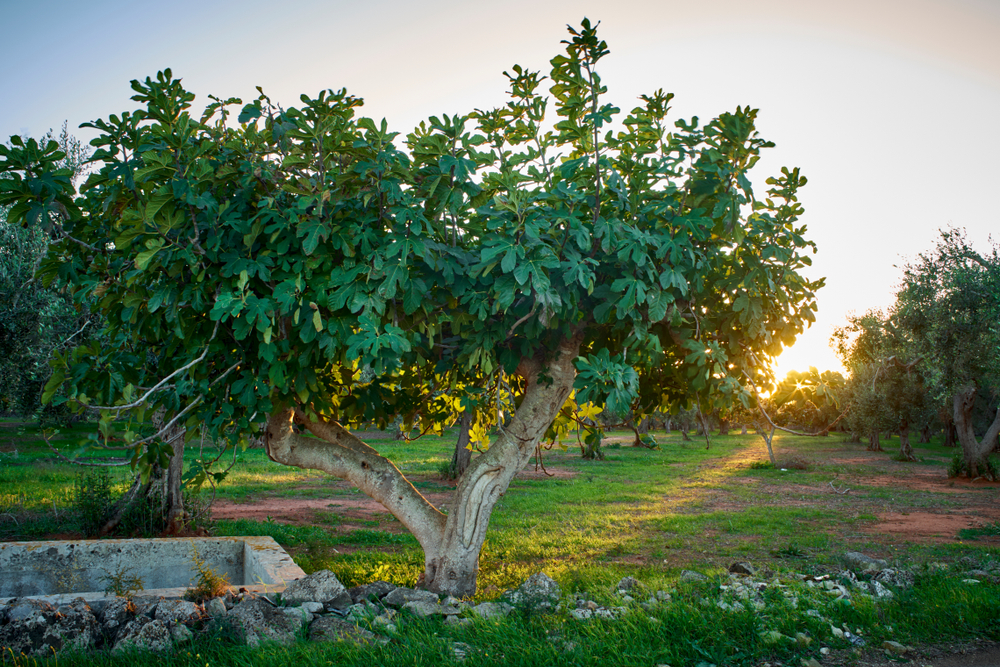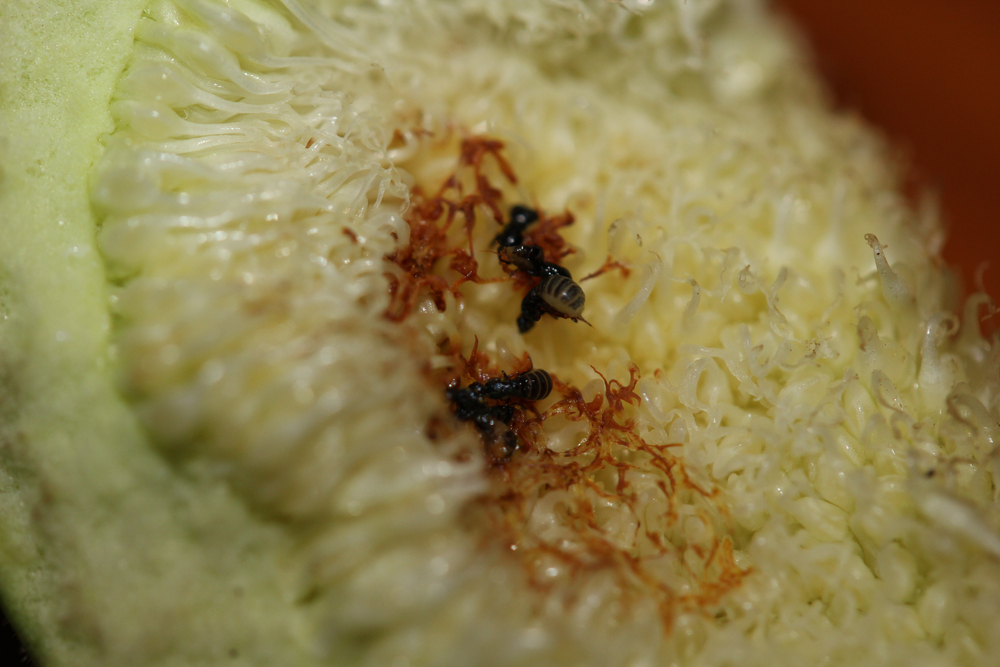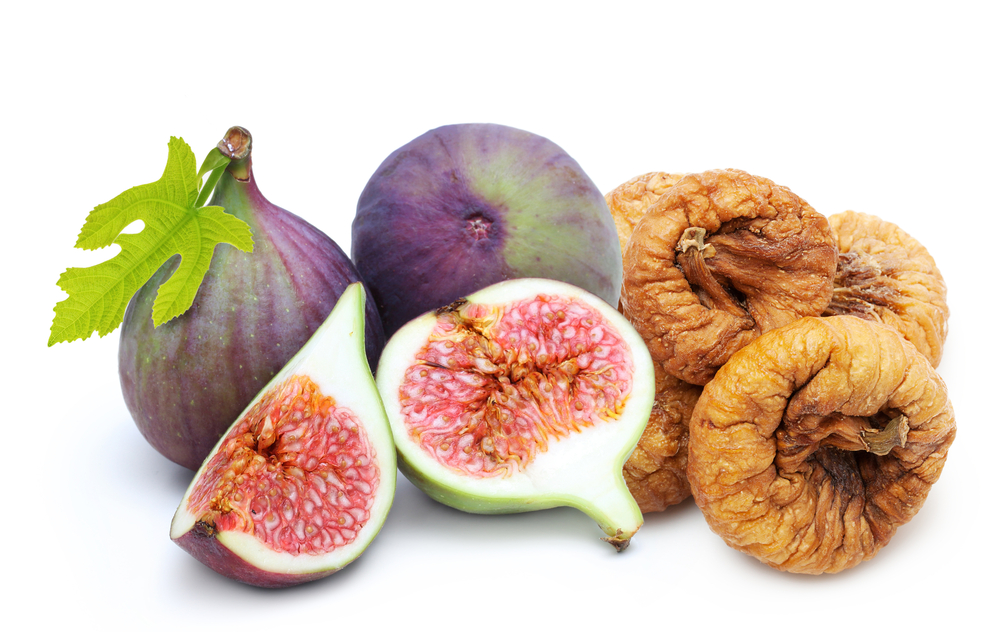The first time I ate a fig I was about 40 years old. I was with my husband Sam, and were staying in a little cottage on a California vineyard that we rented in Sepastopol. One day, we were in the outdoor jacuzzi, which had a big fig tree hanging overhead. So I asked the owner if we could go ahead and sample the figs from the tree. I think they were Black Mission, or maybe Brown Turkey. I didn’t know much about them back then, but either way, they were uh-mazing!
Everything on that beautiful property was edible. It was an absolutely delicious vacation – a fig feast for me! (I was making up for a lifetime of abstinence.) I practically devoured the whole tree! I wish I had tried them sooner in my life, because they instantly catapulted to the top of my love list of fruits. Just last week, I gave my friend a fresh fig to eat, and it was her first time eating one at age 55. She absolutely loved it! It’s never too late to fall in love with figs.
The creepy (crawly) truth about figs
Fig trees don’t flower like apple, orange, or peach trees. Their flowers bloom inside the pod, which later matures into the thing we eat called a fig. Each flower then produces a single, one-seeded, hard-shelled fruit called achene, and fig is made up of multiple achene. And it gets weirder… fig flowers bloom internally, and do not rely on wind or bees to spread their pollen as most flowers do. Instead, they rely on wasps. This is the part of the story where everyone’s least favorite summertime insects get involved and you might get grossed out. Hear me out, okay?

The fig tree cannot survive without the fig wasp to spread its DNA and likewise, the fig wasp can’t live without figs. It’s a symbiotic relationship called “mutualism.”
Here’s how it works: the female fig wasp enters a male (inedible) fig fruit and crawls into the fig through a narrow hole called the “ostiole” which is so cramped and tight that it cuts off her wings and antenna!
The lady fig wasp doesn’t know whether she’s entered a male fig or a female fig. If it’s a male “caprifig” she gets comfy and lays her eggs. The eggs hatch into larvae and grow within the fig’s petals. Male wasp offspring are born blind and flightless, yet the females still find them attractive and hook up with them to create baby wasps. These male wasps try to hit the road immediately afterward (wham, bam, thank you ma’am!) by eating their way out of the fig — basically by creating a tunnel to get out, but unfortunately, it’s a long one, and they end up dying inside because they can’t escape. Sorry if this is TMI!
Female fig wasps can collect a fig’s pollen and crawl out of the tunnel that their dead partners built, and fly away in search of a new fig plant to lay their own eggs. Now, if a female wasp enters a female fig, it’s bad news for her. She won’t be able to lay her eggs because of the stylus. She’ll die inside that fig… but she will have delivered the pollen. Mission accomplished for fig lovers.
Some of you find this interesting, and others are probably mortified. One of my fans named Tom in Alachua, Florida wrote me recently and said that I’m not entirely right about bugs in fruits. See his comments down below.
Are you worried that figs contain wasps? I’ve eaten a million and have never seen one, other than on Google Images. (Don’t do it!) You see, it all ends well. The female figs produce an enzyme called “ficin” which digests the wasp that entered it, thus turning the wasp corpse into pure protein inside the fig.

So, lucky for the squeamish among us, those crunchy things inside the figs are seeds of the fig, not wasp parts. And let me diffuse one other myth: fig jam is NOT sweet baby wasp paste!
Go ahead and visually inspect the figs to see what’s inside them and you’ll see it’s just a bunch of seeds, no critters. Really. Nevertheless, vegans might avoid figs for this reason… because the wasps were needed for the birth of the edible fig fruit… and also they tend to worry that the exoskeleton of the fig wasp may not be 100% digested by the ficin enzyme. I’ve also wondered if figs could trigger allergies in people who are allergic to bees or wasps, but I’m not sure about that.
Now I want to get to the good stuff on figs, because they are pretty amazing in terms of nutrition. They are considered a superfood and they are in season right now.
I love to eat seasonal foods, ideally from my own local area and I’m fortunate enough to live in Colorado where we have an amazing Farmer’s Market in Boulder. I find that my tastes and preferences sometimes change based on the time of year and the weather, with the exception of chocolate which I eat year-round! Especially on stressful days. Anyway, fall is the very best time to find ripe, fresh figs. Visit your local farmer’s market (if you are lucky enough to live in a warm, dry climate) or natural food store to find fresh figs in a multitude of colors and varieties.
Figs are among the oldest cultivated fruits in the world. Ancient Egyptians and Greeks prized figs, in fact, it is thought that early Olympians wore figs around their necks as medals! Can you imagine? Instead of Gold, Silver, or Bronze an athlete might be awarded Black Mission, Calimyrna, or Kadota, lol!
As far as calories, it differs whether you eat fresh or dried figs. For example, 100 gm of fresh figs carry only 74 calories, whereas dried figs confer 249 calories.
You might not know what nutritional powerhouses these little gems are. A 2014 study in the Journal of Food Science closely examined figs and found they contain precious phenolic compounds that are antioxidants, and very good for you, such as apigenin, quercetin, rutin, and luteolin. Those antioxidants are incredible for immunity, vision, and the integrity of your veins (think of bulging veins from hemorrhoids). Man, my column today is really conjuring up a lot of visuals that you might have trouble “unseeing”!

Fresh or dried? Some people like to buy fresh figs and dry them naturally, without the use of commercial sulfur additives. If you’ve wondered whether oven-drying or sun-drying is better, research has already determined this for you.
According to the Journal of Agricultural and Food Chemistry (November 2011), the winner is sun-drying! This preserves the highest content of those precious phenolic compounds like luteolin, quercetin, and others.
Anyway, in addition to those powerhouse antioxidants, figs are an incredible source of minerals, vitamins, and fiber. In fact, figs have the highest mineral and fiber content of all common vegetables, fruits, or nuts!
Fiber
Figs are best known for their fiber content. One medium fig contains about 1.5 grams of fiber – and I’ll bet you can’t eat only one! A serving size is between 3-5 figs, depending on their size, and one serving contains an amazing 20% of your daily recommended fiber intake. Why do you need dietary fiber? Among the many reasons, it helps to keep your digestive system regulated, contributing to healthy weight management and the removal of toxins and waste from your body. Fiber intake also helps to prevent some types of cancers including postmenopausal breast cancer.
Minerals
Figs are an excellent source of several essential minerals, including magnesium, potassium, copper, calcium and manganese. In fact, a serving of figs contains 3% of your daily recommended potassium, contributing to healthy blood pressure management; and 5% of your daily recommended magnesium, vital to brain function and healthy sleep.
Vitamins
Figs are a good source of vitamins B6 and vitamin K, among others.
Antioxidants
The antioxidant and anti-inflammatory properties of figs have been known for years. Figs have been studied in the Mediterranean basin, where they grow plentifully, for their anti-aging benefits. Don’t remove the peel, though, as most of the antioxidants reside there.
Protein
One large fresh fig has about 500 mg of protein, and the dried ones have slightly more, about 620 mg. Compare that with 3 ounces of beef tenderloin which contains about 24 grams of protein.
⚠️ Caution
1. Figs contain a measurable amount of oxalates, which can increase the risk of stones in people who have existing kidney or gallbladder issues.
2. People with diabetes should note that fresh figs are high in fructose or fruit sugar. Dried figs, which are concentrated, are even higher in fructose and should be avoided by folks looking to manage their blood sugar. It’s certainly a good option compared to white refined sugar, but as with all fruits, you have to consider the fructose level.
You might be asking: how do I eat figs? I prefer mine wasp-free on top of a slice of brie on crackers, lol… I’m just messing with you now about the wasps. (Please don’t worry too much about that). Honestly, I love just munching on fresh figs all by themselves.
But you can try them halved with a drizzle of balsamic vinegar, chopped in a bowl of plain yogurt, or sliced on a goat cheese-slathered crostini. I cut them up and add them to fresh salads, it’s so easy and delicious. They make a surprisingly sweet addition when added to grilled cheese sandwiches.
The flavor of figs pairs especially well with apples and pears, also in season this time of year, and you’ll find plenty of delicious recipes online containing any or all three of those delicious ingredients. Here are a couple of my favorite recipes submitted by Michele, who works for me.
No-Bake Fig Energy Bites
INGREDIENTS
6 ounces dried Black Mission figs (use sulfite-free figs if you are sensitive)
4 ounces dates, pits removed
1/4 cup almond butter
3/4 cup old-fashioned oats
1/4 cup almond meal
1 teaspoon pure vanilla extract
DIRECTIONS
Line a small baking sheet with parchment paper. Place all ingredients in the bowl of a food processor fitted with a steel blade. Pulse to combine, then scrape the sides of the bowl. Continue to pulse repeatedly, until the mixture begins to clump, scraping down the bowl as needed. Do not over-process. Once well combined, remove from the bowl and roll the mixture into approximately 18 1-inch balls. Store in an airtight container in the refrigerator for up to two weeks.
Fall Fruit Salad
INGREDIENTS
DRESSING:
1 tablespoon walnut oil
2 tablespoons apple cider vinegar
1 teaspoon maple syrup
½ teaspoon Dijon mustard
1 bag mixed salad greens, including such bitter greens as radicchio, arugula, and/or frisee
4 fresh Brown Turkey figs, sliced
1 large ripe red pear, sliced
½ cup walnuts halved
¼ cup blue cheese or other crumbly cheese
DIRECTIONS
Whisk together the dressing ingredients.
Place salad greens in a serving bowl and arrange fruit, nuts, and cheese attractively on top. Drizzle with dressing and serve.
I hope you enjoy these delicious recipes knowing you are getting amazing health benefits from fabulous, fall-friendly figs. Whether you are 40 or 55 or 80, if the only way you’ve ever had them before is in a fig Newton cookie out of the classic yellow box, you are in for a surprising treat!
Comments from a fig-loving friend named Tom who is ‘in the know’ from Alachua, Florida
(I asked Tom of the varieties mentioned below are Genetically Modified (GMO) but he didn’t know:
https://edis.ifas.ufl.edu/mg214 UF IFAS extension service
Sincerely

Suzy Cohen, has been a licensed pharmacist for over 30 years and believes the best approach to chronic illness is a combination of natural medicine and conventional. She founded her own dietary supplement company specializing in custom-formulas, some of which have patents. With a special focus on functional medicine, thyroid health and drug nutrient depletion, Suzy is the author of several related books including Thyroid Healthy, Drug Muggers, Diabetes Without Drugs, and a nationally syndicated column.
